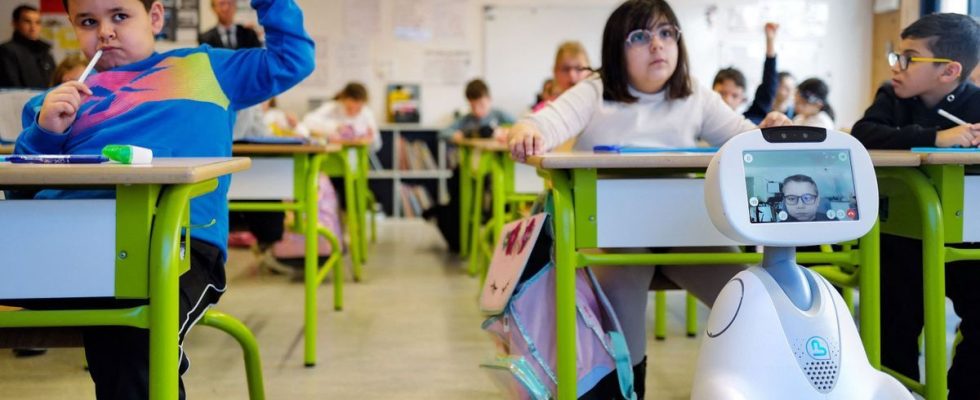Published on
Updated
Reading 3 mins.
“What result did you find?” : Melvin, 8 years old, immobilized at his home in the suburbs of Lyon (south-eastern France) because of cancer, takes part in a course thanks to Buddy, a small robot installed in the first row of his class.
Immaculately white, Buddy looks like a 60 cm tall man surmounted by a head provided with a screen where appears the blond boy with glasses, operated on for a malignant tumor of the brainstem last summer.
Deprived of the use of his right arm, fragile left leg and tired by the disease and the many care he has to undergo, Melvin connects an average of three times a week with his classmates in his elementary class.
“When I’m with Buddy, I feel good, I think I’m in class even if I miss playing games and going to the canteen with my friends and girlfriends“, he confides to AFP, after a distance math course followed in interaction with the teacher and the other students via a tablet.
Buddy is not unique, there are also Beam and Edmo, developed by French start-ups: in total some 4,000 robots are deployed in France as part of the TED-i program (Working together remotely and in interaction) launched in 2020 by the Ministry of Education.
This program is inspired by similar initiatives already launched in several European countries, North America, Australia and Japan. The objective: to allow each student hospitalized or kept permanently at home due to an illness to have free access to a robotic telepresence system.
Besides the continuity of schooling, the idea is that Melvin “feels like everyone else, whether he’s part of the class“, explains his mistress Fanny Joubert.
This 35-year-old school teacher adopted the device in November to allow the student to reconnect with his classmates, worried about not having seen him return at the start of the school year.
“This is done very easily and naturally. Melvin calls, his dad is there to help him in case. And we can see and hear each other“, continues the teacher, who also finds the little convalescent every Tuesday for home lessons.
The schedule is adapted, the interaction is done in small sessions with exercises and revisions. Sometimes also with a more informal exchange time with his comrades.
Get out of your “bubble”
“Press the arrow Melvin! Again !“. This morning, the child is having difficulty moving the little robot’s head, which remains too low. Everything is sorted out thanks to the teacher’s instructions and the lesson can resume.
“Getting started was a little tricky but it’s quite easy and intuitive. We do not use all the features: Melvin could for example make the robot move but it is still complicated for his age“, explains the teacher.
At the end of the lesson, Ms. Joubert returns the robot to the class: “Goodbye Melvin!“, launch in chorus the 27 students, before dispersing in a nice disorder.
“In all diseases, morale is important, and there it brings him a lot. Not being locked in a bubble between home and hospital motivates him“, testifies the father of Melvin, Alexandre Langlois.
Currently on parental leave to take care of his son, this 42-year-old employee in the building praised the device to the parents crossed in the rehabilitation center. “It’s important to keep this link“, he underlines.
In the Lyon academy, 23 robots assist primary and secondary school students.
The tool, the granting of which requires the approval of a doctor, “makes it possible to break the isolation of these students, to bring them a breath of fresh air in their daily lives hit by illness or an accident“, welcomes Olivier Dugrip, an academic manager in the region. According to him, the deployment is destined to continue thanks to the allocation of 170 kits in the academy.
